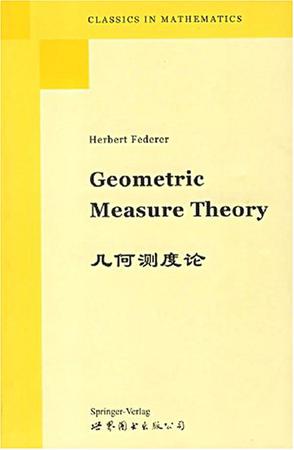几何测度论

作者简介:
Herbert Federer was born on July 23, 1920, in Vienna. After emigrating to the US in 1938, he studied mathematics and physics at the University of California, Berkeley. Affiliated to Brown University, Providence since 1945, he is now Professor Emeritus there. The major part of Professor Federer's scientific effort has been directed to the development of the subject of Geometric Measure Theory, with its roots and applications in classical geometry and analysis, yet in the functorial spirit of modern topology and algebra. His work includes more than thirty research papers published between 1943 and 1986, as well as this book.
内容简介:
This book aims to fill the need for a comprehensive treatise on geo-metric measure theory. It contains a detailed exposition leading from the foundations of the theory to the most recent discoveries, including many results not previously published. It is intended both as a reference book for mature mathematicians and as a textbook for able students. The material of Chapter 2 can be covered in a first year graduate course on real analysis. Study of the later chapters is suitable preparation for re-search. Some knowledge of elementary set theory, topology, linear algebra and commutative ring theory is prerequisite for reading this book, but the treatment is selfcontained with regard to all those topics in multilinear algebra, analysis, differential geometry and algebraic topology which occur. 本书为英文版。
目录:
introduction chapter one grassmann algebra 1.1. tensor products 1.2. graded algebras 1.3. the exterior algebra of a vectorspace 1.4. alternating forms and duality 1.5. interior multiplications 1.6. simple m-vectors 1.7. inner products 1.8. mass and comass 1.9. the symmetric algebra of a vectorspace 1.10. symmetric forms and polynomial functions chapter two general measure theory 2.1. measures and measurable sets 2.1.1. numerical summation 2.1.2.-3. measurable sets 2.1.4.-5. measure hulls 2.1.6. ulam numbers .2.2 borel and suslin sets 2.2.1. borel families 2.2.2. -3. approximation lay closed subsets 2.2.4. -5. nonmeasurable sets 2.2.5. radon measures 2.2.6. the space of sequences of positive integers 2.2.7. -9. lipschitzian maps 2.2.10.-13. suslin sets 2.2.14.-15. borel and baire functions 2.2.16. separability of supports 2.2.17. images of radon measures 2.3 measurable functions 2.3.1.-2. basic properties 2.3.3.-7. approximation theorems 2.3.8.-10. spaces of measurable functions 2.4. lebesgue integration 2.4.1.-5. basic properties 2.4.6.-9. limit theorems 2.4.10.-11. integrals over subsets 2.4.12.-17. lebesgue spaces 2.4.18. compositions and image measures 2.4.19. jensen's inequality 2.5. linear functionals 2.5.1. lattices of functions 2.5.2.-6. daniell integrals 2.5.7.-12. linear functionals on lebesgue spaces 2.5.13.-15. riesz's representation theorem 2.5.16. curve length 2.5.17.-18. riemann-stieltjes integration 2.5.19. spaces of daniell integrals 2.5.20. decomposition of daniell integrals 2.6. product measures 2.6.1.-4. fubini's theorem 2.6.5. lebesgue measure 2.6.6. infinite cartesian products 2.6.7. integration by parts 2.7. invariant measures 2.7.1.-3. definitions 2.7.4. -13. existence and uniqueness of invariant integrals 2.7.14.-15. covariant measures are radon measures 2.7.16. examples 2.7.17. nonmeasurable sets 2.7.18. l1 continuity of group actions 2.8. covering theorems 2.8.1.-3. adequate families 2.8.4. -8. coverings with enlargement 2.8.9.-15. centered ball coverings 2.8.16.-20. vitali relations 2.9. derivates 2.9.1.-5. existence of derivates 2.9.6.-10. indefinite integrals 2.9.11.-13. density and approximate continuity 2.9.14.-18. additional results on derivation using centered balls 2.9.19.-25. derivatives of curves with finite length 2.10. carathdeodory's construction . 2.10.1. the general construction 2.10.2.-6. the measures 2.10.7. relation to riemann-stieltjes integration 2.10.8.-11. partitions and multiplicity integrals 2.10.12.-14. curve length 2.10.15.-16. integralgeometric measures 2.10.17.-19. densities 2.10.20. remarks on approximating measures 2.10.21. spaces of lipschitzian functions and closed subsets 2.10.22.-23. approximating measures of increasing sequences 2.10.24. direct construction of the upper integral 2.10.25.-27. integrals of measures of counterimages 2.10.28.-29. sets of cantor type 2.10.30.-31. steiner symmetrization 2.10.32.-42. inequalities between basic measures 2.10.43.-44. lipschitzian extension of functions 2.10.45.-46. cartesian products 2.10.47.-48. subsets of finite hausctorll measure chapter three rectifiability 3.1 differentials and tangents 3.1.1.-10. differentiation and approximate differentiation 3.1.11. higher differentials 3.1.12.-13. partitions of unity 3.1.14.-17. differentiable extension of functions 3.1.18. factorization of maps near generic points 3.1.19.-20. submanifolds of euclidean space 3.1.21. tangent vectors 3.1.22. relative differentiation 31.1.23. local flattening of a submanifold 3t.l.24. analytic functions 3.2 area and coarea of lipschitzian maps 3.2.1. jacobians 3.2.2. -7. area of maps of euclidean spaces 3.2.8.-12. coarea of maps of euclidean spaces 3.2.13. applications; euler's function f 3.2.14.-15. rectifiable sets 3.2.16.-19. approximate tangent vectors and differentials 3.2.20.-22. area and coarea of maps of rectifiable sets 12.23.-24. cartesian products 3.2.25.-26. equality of measures of rectifiable sets .1.2.27. areas of projections of rectifiable sets 37.28. examples 3.2.29. rectifiable sets and manifolds of class 1 3.2.30.-33. further results on coarea 3.2.34.-40. steiner's formula and minkowski content 3.2.41.-44. brunn-minkowski theorem 3.2.45. relations between the measures 3.2.46. hausdorff measures in riemannian manifolds 3.2.47.-49. integralgeometry on spheres 3.3 structure theory 3.3.1.-4. tangential properties of arbitrary suslin sets 3.3.5-18. rectifiability and projections 3.3.19.-21. examples of unrectifiable sets 1.3.22. rectifiability and density 3.4. some properties of highly differentiable functions 3.4.1.-4. measures off{x: dim im df(x)[v} 3.4.5.-12. analytic varieties chapter four homological integration theory 4.1. differential forms and currents 4.1.1. distributions 4.1.2.-4. regularization 4.1.5. distributions representable by integration 4.1.6. differential forms and m-vectorfields 4.1.7. currents 4.1.8. cartesian products 4.1.9.-10. homotopies 4.1.11. joins, oriented simplexes 4.1.12.-19. flat chains 4.1.20.-21. relation to integralgeometry measure 4.1.22.-23. polyhedral chains and flat approximation 4.1.24.-28. rectifiable currents 4.1.29. lipschitz neighborhood retracts 4.1.30. transformation formula 4.1.31. oriented submanifolds 4.1.32. projective maps and polyhedral chains 4.1.33. duality formulae 4.1.34. lie product of vectorfields 4.2. deformations and compactness 4.2.1. slicing normal currents by real valued functions 4.2.2. maps with singularities 4.2.3. -6. cubical subdivisions 4.2.7.-9. deformation theorem 4.2.10. isoperimetric inequality 4.2.11.-14. flat chains and integralgeometric measure 4.2.15.-16. closure theorem 4.2.17.-18. compactness theorem 4.2.19.-24. approximation by polyhedral chains 4.2.25. indecomposable integral currents. 4.2.26. flat chains modulo v 4.2.27. locally rectifiable currents 4.2.28.-29. analytic chains 4.3. slicing 4.3.1.-8. slicing flat chains by maps into rn 4.3.9.-12. homotopies, continuity of slices 4.3.13. slicing by maps into manifolds 4.3.14. oriented cones 4.3.15. oriented cylinders 4.3.16.-19. oriented tangent cones 4.3.20. intersections of flat chains 4.4. homology groups 4.4.1. homology theory with coefficient group z 4.4.2.-3. isoperimetric inequalities 4.4.4. compactness properties of homology classes 4.4.5.-6. homology theories with coefficient groups r and z 4.4.7. two simple examples 4.4.8. homotopy groups of cycle groups 4.4.9. cohomology groups 4.5 normal currents of dimension )/in rn 4.5.1.-4. sets with locally finite perimeter 4.5.5. exterior normals 4.5.6. gauss-green theorem 4.5.7.-10. functions corresponding to locally normal currents 4.5.11.-12. densities and locally finite perimeter 4.5.13.-17. examples and applications chapter five applications to the calculus of variations 5.1 integrands and minimizing currents 5.1.1. parametric integrands and integrals 5.1.2 ellipticity of parametric integrands 5.1.3. convexity, parametric legendre condition 5.1.4. diffeomorphic invariance of ellipticity 5.1.5 lowersemicontinuity of the integral 5.1.6 minimizing currents 5.4.7.-8 isotopic deformations, variations 5.1.9 nonparametric integrands 5.1.10 nonparametric legendre condition 5.1.11 euler-lagrange formulae 5.2 regularity of solutions of certain differential equations 5.2.1.-2. la and h6tder conditions 5.2.3. strongly elliptic systems 5.2.4. sobolev's inequality 5.2.5.-6. generalized harmonic functions 5.2.7.-10. convolutions with essentially homogeneous functions 5.2.11.-13. elementary solutions 5.2.14. hflder estimate for linear systems 5.2.15.-18. nonparametric variational problems 5.2.19. maxima of real valued solutions 5.2.20 one dimensional variational problems and smoothness 5.3.1.-6. estimates involving excess 5.3.7. a limiting process 5.3.8-13. the decrease of excess 5.3.14.-17. regularity of minimizing currents 5.3.18.-19. minimizing currents of dimension m in rm+1 5.3.20. minimizing currents of dimension i in rn 5.3.21. minimizing flat chains modulo v 5.4 further results on area minimizing currents 5.4.1. terminology 5.4.2. weak convergence of variation measures 5.4.3.-5. density ratios and tangent cones 5.4.6.-7. regularity of area minimizing currents 5.4.8.-9. cartesian products 5.4.10.-14. study of cones by differential geometry 5.4.15.-16. currents of dimension tn in rm+l 5.4.17. lack of uniqueness and symmetry 5.4.18. non parametric surfaces, bernstein's theorem 5.4.19. holomorphic varieties 5.4.20. boundary regularity bibliography glossary of some standard notations list of basic notations defined in the text index




评论